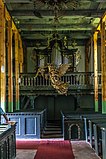Joachim Wagner (organ builder)
Joachim Wagner (born April 13, 1690 in Karow , Duchy of Magdeburg , † May 23, 1749 in Salzwedel , Mark Brandenburg ) was an important organ builder in Brandenburg .
origin
Joachim Wagner was born as the son of pastor Christoph Wagner (1653–1709) and his wife Anna Dorothea. Tiefenbach was born in Karow near Genthin . His brothers, pastors Johann Christoph Wagner (1683–1750, successor to his father's office in Karow since 1710) and Friedrich Wagner (1693–1760), later had an influence on his work.
Act
Joachim Wagner may have learned the organ building trade from the Schnitger student Matthäus Hartmann († around 1745). It has been proven that Christoph Treutmann d. Ä. (around 1673–1757) was Wagner's teacher in Magdeburg . Wagner went on a journey as a journeyman and also worked for Gottfried Silbermann in Freiberg for two years . In 1719 he came to Berlin. He completed his masterpiece there in 1723 with the organ in the Marienkirche in Berlin (consecrated in 1721), which had three manuals and 40 stops . In Berlin he also built his largest work with 50 registers on three manuals in the newly built Berlin garrison church from 1724 to 1726 (rebuilt in 1892, burned in 1908).
He was by far the most important organ builder of the Baroque period in the Margraviate of Brandenburg, as the conditions offered were particularly favorable during the reign of the soldier king Friedrich Wilhelm I (1713–1740). He is sometimes referred to as "Märkischer Silbermann".
Joachim Wagner apparently died in Salzwedel while working on his last organ for the Marienkirche there , as it was completed by Gottlieb Scholtze .
student
Among his students who carried on his traditions were
- Matthias Kallensee, since 1720, later foreman, died in 1741
- Johann Peter Migendt , since 1731/32, foreman since 1741, took over the workshop in 1749
- Heinrich Andreas Contius , 1732 to around 1738, then the most important organ builder in the Baltic States
- Georg Neumann, 1732-1742
- Gottlieb Scholtze , 1740/44 carving work for Wagner, then organ building student
- Johann Gottlob Mehner , since 1746 at the latest, then organ builder in Stettin
- Ernst Julius Marx , possibly only with Migendt after 1749 ?, then organ builder in Berlin
Organs
Effective range
In the course of his life, Joachim Wagner built over 50 individually designed organs, both for large churches and for smaller village churches, 15 of which have been preserved in larger parts, as well as eight cases or smaller remains. From his workshop in Berlin, his area of activity extended mainly to the northern German Prussian - Hohenzollern states, in addition to the royal cities of Berlin (8 organs) and Potsdam (4) and Brandenburg an der Havel (3) to the entire Mark Brandenburg including Altmark ( Werben (Elbe) , Salzwedel ), Uckermark ( Angermünde , Gramzow , Schwedt / Oder ) and Neumark ( Königsberg ), on Pomerania ( Stargard , Wartin ) and the Duchy of Magdeburg (Magdeburg). But he also built organs in Kursachsen ( Jüterbog ) and Norway ( Nidaros Cathedral in Trondheim ). Fifteen organs with the largest original components are preserved today, the most valuable in the Brandenburg Cathedral, as well as eight cases or smaller remains.
Characteristic
Joachim Wagner built instruments that combined and further developed central and north German elements of organ building. The working principle cultivated in the baroque of northern Germany was abandoned in favor of a fusion of sounds and a single overall housing. To the sound peculiarities include the powerful intonation , the well-staffed pedal (without pedal coupler) terzhaltige concoctions and manual transmissions built in some instruments.
In the course of his life he built over fifty individually designed organs, both for large churches and for small village churches, none of which are completely alike. His organ cases were varied and often wore plastic jewelry and occasionally movable timpani and trumpet angels in the Silesian tradition, inspired by Johann Michael Röder . All of these instruments are extremely valuable evidence of a highly developed musical culture, which was also used by the great musicians of his time. On May 8, 1747, for example, Johann Sebastian Bach gave a concert on the relatively small Wagner organ in Potsdam's Heilig-Geist-Kirche . The organ works of his son Carl Philipp Emanuel Bach were created around the house organ of Princess Anna Amalia , built in 1755 by Ernst Marx and Peter Migendt , which is now in Berlin-Karlshorst .
Present stock
Fires, inadequate care and renovations resulting from the musical zeitgeist of the 19th century and the consequences of the Second World War have left only 15 more or less original instruments and eight other remains of instruments, mainly cases (some still with original inventory). In the course of its existence, the Potsdam company Schuke has made a great contribution to the restoration of Wagner organs.
On August 26th, 2006 the Joachim Wagner Society was founded in Rühstädt , which aims to research and maintain its unique heritage.
List of works
Today, 51 new organs, a layout draft, four relocations and some repairs are known by Joachim Wagner. Obtained 15 organs in larger parts and eight brochures , some with small residues. The most important surviving Wagner organ is in the Brandenburg Cathedral .
The size of the instruments is indicated in the fifth column by the number of manuals and the number of sounding registers in the sixth column. A capital “P” stands for an independent pedal, a lowercase “p” for an attached pedal. A italics indicates that the organ in question has not survived more or only nor the prospectus of Wagner dates.
| year | place | building | image | Manuals | register | Remarks |
|---|---|---|---|---|---|---|
| 1720-1723 | Berlin | St. Mary |

|
III / P | 40 | Prospectus and register preserved, integrated in the new building by Alfred Kern & fils (2002) |
| 1722-1723 | Potsdam | Old garrison church | II / P | 25th | 1732 in the Jerusalem church , Berlin, situated; Dismantling around 1878 when the church was rebuilt; not received | |
| 1725 | Brandenburg on the Havel | St. Peter and Paul Cathedral | II / P | 33 | Prospectus, register and pipes almost completely preserved in the original, largest preserved and fully functional Wagner organ → organ | |
| 1724-1726 | Berlin | Garrison Church | III / P | 50 | not received | |
| 1724-1726 | Berlin | Riding house | II / P | 18th | not received | |
| 1726-1727 | Blumberg | Village church | I. | 7th | not received | |
| 1726-1727 | Brandenburg on the Havel | St. Catherine's |

|
III / P | 40 | Get prospectus → Organ |
| 1727 | Berlin | St. Georgen | II / P | 16 | not received | |
| 1727 | Berlin | Great Friedrichs Hospital, orphanage church | I / P | 9-10 | not received | |
| 1728 | Bad Freienwalde (Oder) | St. Nikolai |
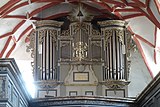
|
II / P | 24 | Prospectus received |
| 1729-1730 | Spices | St. Mary | III / P | 34 | not received | |
| 1730 | Templin | Maria Magdalenen Church | II / P | 30th | not received | |
| 1730 | Potsdam | Holy Spirit Church | II / P | 22nd | not received | |
| 1730-1731 | Stargard | Johanniskirche | II / P | 21st | not received | |
| 1731 | Berlin | St. Gertraud, Hospital Church | I. | 9 | not received | |
| 1731-1732 | Berlin | Parochial Church | II / P | 32 | not received | |
| 1731-1732 | Potsdam | Garrison Church | III / P | 42 | not received | |
| 1733 | Zehdenick | Zehdenick town church | II / P | 18th | not received | |
| 1732-1734 | Berlin-Spandau | St. Nicholas Church | II / P | 31 | not received | |
| 1734 | Berlin | French Friedrichstadtkirche | I / P | 13 | not received | |
| 1734-1735 | Altwriezen | Village church | I. | 6th | not received | |
| 1734-1736 | Koenigsberg in the Neumark | St. Mary | III | 45 | not received | |
| 1735-1736 | Nahausen near Königsberg in Neumark | Village church | I. | 7th | not received | |
| 1735 | Schwedt / Oder | Castle chapel | I / P or II / P | 15 or 21 | Drafts from September 19, 1735, implementation unknown | |
| 1736 | Gramzow | Ev. City Church of St. Mary |

|
I / P | 9 | in the Sternhagen village church since 1857 , restored and reconstructed by Schuke from 2001–2009 |
| ? around 1736 | Zachow (Czachów), Neumark | Village church | I. | 7th | Sideways parapet organ without pedal, 1837 conversion of Buchholz with pedal, 1945 all metal pipes disappeared, 2003 discovery of Wagner's authorship by Karl Richter, today an empty prospectus with Buchholz pedal wooden pipes | |
| 1736-1737 | Brandenburg on the Havel | St. Gotthardt | II / P | 31 | not received | |
| 1737 | Potsdam | Church of the Military Orphanage |
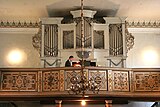
|
I. | 8th | since 1792 in the church of St. Marien in Pritzerbe |
| 1737 | Jueterbog | Church of Our Lady |
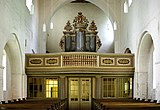
|
I / P | 13 | largely preserved → organ |
| 1737-1738 | Bochow (Niedergörsdorf) | Village church | I / p | 7 or 9 | not received | |
| 1738 | Rühstädt | Village church | I / P | 10 | Housing and some registers preserved, the rest of the reconstruction | |
| 1737-1739 | Bruessow | St. Sophia | I / P | 11 | not received | |
| 1739 | Schönwalde | Village church |

|
I / P | 12 | preserved → organ |
| 1738-1740 | Magdeburg | Holy Spirit Church | III / P | 46 | not received | |
| 1737-1741 | Jueterbog | St. Nikolai |

|
II / P | 32 | The prospectus has been preserved; like the organ, it was built by J. Ch. Angermann from 1737 to 1741. When the organ was built, parts of the previous organ from 1602 were used → organ . |
| 1739-1741 | Treuenbrietzen | St. Mary |

|
II / P | 30th | receive |
| 1739-1741 | Trondheim , Norway | Nidaros Cathedral |
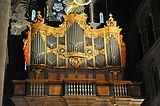
|
II / P | 30th | Restored in 1994 → organ |
| 1741 | Treuenbrietzen | St. Nikolai | I / P | 18? | not received | |
| 1741 | Neuruppin | Saint Mary's | III / P | 42 | not received | |
| 1742 | Wusterhausen / Dosse | St. Peter and Paul | II / P | 29 | rescheduled several times; Restored in 1978 | |
| 1741-1742 | Bötzow | St. Nikolai | I / P | 10 | repeatedly rescheduled | |
| 1742-1744 | Angermünde | City parish church St. Marien |

|
II / P | 30th | Four timpani angels can be operated from the pedal. 1773 painting of the prospectus; 1845 and 1899–1901 rearrangements; 1967–1976 restoration in two stages by Schuke |
| 1743-1744 | Wartin | Ev. church | I / P | 9 | expanded by Christian Friedrich Voit; largely preserved | |
| 1744-1745 | Gransee | St. Mary | II / P | 21st | Prospectus and some pipes received | |
| 1744-1745 | Passow | Village church | I / P | 9 | rescheduled several times; Housing and partly pipework preserved | |
| 1744-1745 | ? | ? | II | 12 | Wagner's only surviving transmission organ, original location not known; since 1802/03 in Warsaw , St. Benon Church, from 1824 in Pruszyn , dismantled and stored in 1969, restored from 2008–2010 and re-erected in the bishop's house in Siedlce | |
| around 1745 | Felchow | Ev. church | I. | 9 | changed several times | |
| 1745 | Flemsdorf | Village church | I. | 8th | little received | |
| 1745-1746 | Ragow (Mittenwalde) | Holy Spirit Church | I / P | 8th | not received | |
| 1747 | Advertise (Elbe) | St. Johannis |

|
II / P | 27 | 1916 converted to pneumatics by Albert Kohl, prospectus and 11 registers preserved. The restoration in the spirit of Wagner is planned. |
| 1748 | Berlin | St. Petri | III / P | 50 | Supplemented by Migendt in 1751, lost by fire in 1908 | |
| 1748-1749 | Salzwedel | St. Mary |
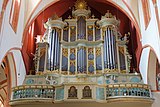
|
III / P | 39 | Completion by Scholtze, prospectus received |
literature
- Heinz Herbert Steves: The organ builder Joachim Wagner (1690–1749). In: Archiv für Musikforschung 4, 1939, pp. 321–358 and 5, 1940, pp. 17–38. Also special print as Diss. Phil. (Cologne 1939): Leipzig 1939.
- Arthur Jaenicke: The pure sound. A story from the life of the organ builder Joachim Wagner. Evangelische Verlagsanstalt, Berlin 1957. (With biographical introduction, overview of known Wagner organs and glossary on organ building)
- Claus-Peter Schulze: Wagner, Joachim. In: Music in the past and present. Vol. 14, 1968, Col. 77-78.
- Gernot Schmidt: Joachim Wagner's organs and their restorations. In: The Organ Yearbook. 11, 1980, pp. 31-47.
- Wolf Bergelt : The Mark Brandenburg. A rediscovered organ landscape. Berlin 1989, pp. 15-22 and 104-106.
- Eitelfriedrich Thom (ed.): The organ builder Joachim Wagner (1690–1749). Michaelstein / Blankenburg 1990.
- Berthold Schwarz (Ed.): 500 years of organs in Berlin's Protestant churches. Berlin 1991, Vol. I, pp. 62-69 and Vol. II, pp. 486-488.
- Andreas Kitschke: The organ buildings by Joachim Wagner (1690–1749) in the royal seat of Potsdam. In: Acta Organologica . 23, 1993, pp. 197-240. [With list of works and illustrations.]
- Wolf Hobohm, Friedrich Wagner: Notes about a Hamburg main pastor from the perspective of Telemann research. In: Music culture in Silesia at the time of Telemann and Dittersdorf . Sinzig 2001, pp. 129-146.
- Dietrich Kollmannsperger: Wagner, Joachim. In: The New Grove Dictionary of Music and Musicians . Vol. 26. 2nd edition. London, New York 2002, p. 974.
- Uwe Czubatynski: Bibliography on the history of the organ in Berlin-Brandenburg. 2nd updated edition (electronic resource). Rühstädt 2005.
- Uwe Czubatynski: History and restoration of the Wagner organ in Rühstädt. In: Messages from the Association for the History of Prignitz . 6, 2006, pp. 84-91.
- Wolf Bergelt : Joachim Wagner (1690–1749) organ maker. Schnell and Steiner, Regensburg 2012, ISBN 978-3-7954-2562-3 .
- Uwe Czubatynski : Wagner, Joachim. In: Biographisch-Bibliographisches Kirchenlexikon (BBKL). Volume 26, Bautz, Nordhausen 2006, ISBN 3-88309-354-8 , Sp. 1547–1551.
Individual evidence
- ↑ Andreas Kitschke : The teacher of Joachim Wagner. In: Ars Organi . Volume 59, 2011, p. 200.
- ↑ a b Andreas Kitschke: The organ builder Joachim Wagner. In: Evangelical church community Schönwalde: The historical Wagner organ (1739) in the village church Schönwalde. Schönwalde-Glien 2015, p. 10 f.
- ↑ Christhard Kirchner, Uwe Pape: Joachim Wagner . In: Uwe Pape, Wolfram Hackel, Christhard Kirchner (eds.): Lexikon norddeutschet organ builder. Volume 4. Berlin, Brandenburg and the surrounding area. Pape Verlag, Berlin 2017. p. 599
- ↑ Christhard Kirchner, Uwe Pape: Wagner, Joachim . In: Uwe Pape, Wolfram Hackel, Christhard Kirchner (Eds.): Lexicon of North German Organ Builders. Volume 4. Berlin, Brandenburg and the surrounding area. Pape Verlag, Berlin 2017. pp. 599f. with extensive list
- ^ Joachim Wagner - Catalog raisonné of the Institute for Organ Research Brandenburg. Retrieved April 17, 2018 .
- ^ Draft of the manuscript for the Brandenburg Institute for Organ Research
- ^ Draft of the Brandenburg Institute for Organ Research (pdf)
- ↑ Photo of the historical organ Institute for Organ Research Brandenburg
- ^ Organ in Sternhagen , accessed on April 17, 2018.
- ↑ Schinkel and a riddle text by Karl Richter, with history and dispositions (pdf)
- ^ Photo Institute for Organ Research Brandenburg
- ↑ year of implementation according to www.garnisonfriedhofberlin.de , accessed on April 17, 2018.
- ↑ organ in rühstädt , accessed on 17 April 2018th
- ^ Marie-Luise Buchinger, Marcus Cante: Monuments in Brandenburg, Teltow Fläming district, Part 1: City of Jüterbog with Zinna monastery and Niedergörsdorf community. Wernersche Verlagsgesellschaft, ISBN 3-88462-154-8 , p. 79.
- ↑ Times according to Nidaros Cathedral: Wagner organ , accessed on April 17, 2018.
- ^ Organ in Wusterhausen , accessed on April 17, 2018.
- ↑ Time according to the organ in Gransee , accessed on April 17, 2018.
- ↑ Restoration of the Wagner transmission organ completed. Retrieved April 17, 2018 .
- ↑ www.volksstimme.de: Professor wants to save Werben's organ, November 29, 2017, accessed on November 3, 2019
Web links
| personal data | |
|---|---|
| SURNAME | Wagner, Joachim |
| BRIEF DESCRIPTION | German organ builder |
| DATE OF BIRTH | April 13, 1690 |
| PLACE OF BIRTH | Karow (near Genthin) |
| DATE OF DEATH | May 23, 1749 |
| Place of death | Salzwedel |







